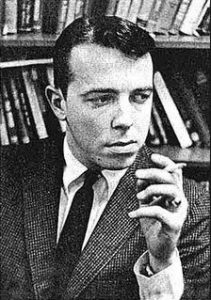
Photo info …
Credit: Terry Ellen (Todd) Ferl via Find A GraveView Source
(July 20, 1934-Mar. 3, 2015). M. Stanton Evans was a leading young conservative journalist in the late 1950s, looking like another William F. Buckley, a leading conservative personality.
Indianapolis newspaper publisher was searching for intelligent conservative commentators. “There are lots of good journalists around,” he told magazine. “But they’re all cockeyed left-wingers.”
Then he found Stan Evans. Evans was a well-read believer in small government and saw Christian faith as an important foundation for a free society. Assigned to supervise the editorial pages of the afternoon , he quickly established himself as an influential Midwest commentator. In those days morning and evening newspapers had almost an equal number of readers, with many reading the news after coming home from work. Readership of the evening covered almost half the city, with the morning having slightly more. Some households received two daily newspapers. The had competition from the more liberal .
The conservative movement nationally in the 1960s was a minority movement in a minority political party. Democrats dominated national politics and were equal to the Republicans at the state level. Nationally the conservatives won the presidential nomination in 1964 with Barry Goldwater but took a beating from the Democrats and President Lyndon Johnson.
Editor at 26, Evans was intimidating to liberals or anyone who debated him. Yet he was influential regionally and nationally, contributing stories to magazine. He also wrote 10 books over his lifetime.
When Vice President Spiro Agnew made speeches about a liberal news media slant and a silent conservative majority, magazine poked fun at speechless conservatives. “If the Silent Majority Could Speak, What Would They Say?” They identified Indy as “the heart of America’s innermost boondock.” They profiled Evans and radio commentator Paul Harvey as influential Midwestern voices, taking note of their defense of free-market capitalism and small government.
By the early 1970s, Evans, 40, became restless, asking to be free of editorial page duties. He launched a syndicated column, moving to Washington D.C., and indianapolis—starting the National Journalism Center to offer student journalism internships.
He never identified with what became known as the Religious Right and saw himself as a believing Christian without thinking of himself as a good Christian. The Religious Right, led by Virginia-based television preachers Jerry Falwell and Pat Robertson, boosted Ronald Reagan in 1980, helping Reagan win the presidency and boosting the conservative influence among Republicans. More quietly Evans offered substantial research in his 1995 book, , that the Christian faith was the foundation for the American conservative movement. He was building on the Pulliam newspaper motto of II Corinthians 3:17 (“Where the spirit of the Lord is, there is liberty.”).

Help improve this entry
Contribute information, offer corrections, suggest images.
You can also recommend new entries related to this topic.

